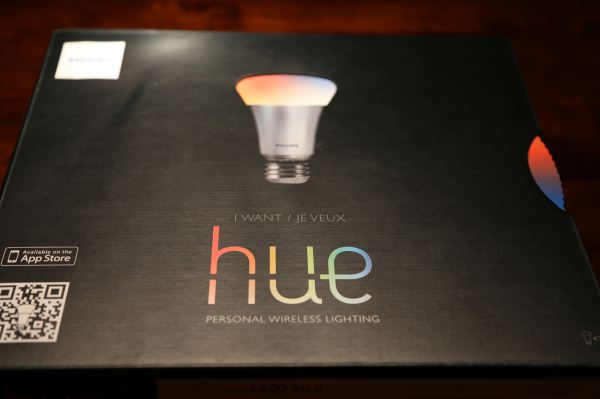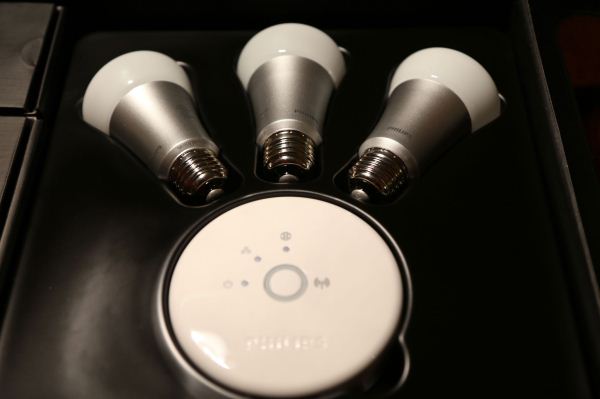Philips Hue: Automated Home Lighting Gets Colorful
by Ashu Joshi on March 1, 2013 12:50 AM EST- Posted in
- Gadgets
- Home Automation
- Philips
- Hue
- Lighting
Introducing the Philips Hue
Before we get started, we’d like to introduce Ashu Joshi to our readers. He has a background in networking and has used a variety of home automation devices over the years. As such, he brings a useful perspective to our staff and can help augment our review coverage. Note also that as with all of our articles, these pieces reflect the opinions of the writer(s) and are not in any way associated with or influenced by any other source (e.g. other employers).
Philips sent out a review sample of their new Hue lighting system, a set of three Hue lights with the Hue Bridge that allows you to remotely control the lights. Besides being able to turn the lights on or off, the big claim to fame of the Hue is that you can set the lights to a variety of colors, or you can even program them to cycle through colors. Home automation systems are often proprietary and can be quite expensive, so the entry of Philips into this market (albeit in a limited fashion) with their Hue lighting system has the potential to shake things up a bit.
The lights have colored LEDs, and while the initial pack only includes three Connected Bulbs (referred to informally as "bulb" or "light" throughout the remainder of this review), you can potentially add up to 50 lights throughout your house/property. One thing that hasn’t changed yet however is that pricing is quite high: the initial Starter Pack will set you back $200. But how does the Philips Hue work in practice, and could it be worth the cost of entry? Note that at present, the Philips Hue is only appears to be sold through the Apple Store as an “App-Enabled Accessory”, but Android is also supported. Long-term we will likely see support for other operating systems as well, but for now this is primarily an iOS/Android targeted device.
Packaging and Contents
One thing that immediately stands out with the Philips Hue is the packaging. It’s very well designed and eye-catching, and I love that you’re able to get a preview of the lighting options with the dial on the box. I set up my Philips Hue controller and bulbs recently, and my initial impressions have been very positive. It’s very easy to install and the experience of this lighting system is quite the change from your everyday lights. I uploaded a few videos of the package in action so you can see what it looks like.
Included in the package are three Connected Bulbs, and they’re quite a bit heavier than a typical light bulb. Most likely the added weight comes from the controller and antenna necessary to talk to the network, and possibly the addition of multi-colored LEDs adds a bit as well. Whatever the reason for the added weight, at least the heft makes you feel like you’re getting a bit extra for the $60 per light.
The other major item included with the Starter Pack is the Hue Bridge. This is a small, circular, lightweight controller with three LEDs on the top and a large circular button in the center used for the pairing function—Philips refers to it as the “link” button. On the side is an Ethernet port to connect to the home network and a power receptacle. The three LEDs show the status of Power, Ethernet, and Internet connections. There is no lettering to indicate what the LEDs are for but they use fairly common icons to indicate the function.
You also get a power adapter with a reasonably long cable for the Hue Bridge, though this is somewhat subjective. I have seen plenty of products where to save pennies they have short cables that ruin the setup experience and force the use of an extension cord, but for most users the Hue adapter should prove sufficiently long. An Ethernet cable is also provided to connect the Hue Bridge to your network, so plan ahead and realize that the Hue Bridge will need both power and network wires and place it accordingly.


















94 Comments
View All Comments
Lord 666 - Friday, March 1, 2013 - link
Ok Super Sleuth. On your LinkedIn, does it say you work for the CIA, NSA, or Mossad?Egg - Friday, March 1, 2013 - link
None of those.I'm in high school.
BrokenCrayons - Friday, March 1, 2013 - link
Oh look a new person posting reviews at Anandtech. Let's be big meanie-heads right away instead of saying hi and welcoming someone who's just getting started. That won't make them jaded or plant the seeds that cause them to feel subversively belligerent toward the readers.I, for one, am happy to say, "Welcome Ashu! It's great to see someone new and we look forward to reading your work in the future," even if some people are having a case of the internet grumpy-wumpies.
Egg - Friday, March 1, 2013 - link
I didn't comment on this article - at two in the morning - to flame, troll, deface, or hate on Anandtech. I don't think you can accuse me of that, if you look at my language. If you're somehow offended by "a bit deceptive," "I'm not sure how I feel," and "I don't see Brian Klug posting his reviews on his blog," I apologize. Yet I see far, far, worse elsewhere on this site.So why did I write a comment, when I should have been studying for a test the day after?
I've been a reader of many, many, tech websites: Tom's Hardware, HardOCP, The Verge, Engadget, Silent PC Review, techpowerup, AndroidCentral... the list goes on.
However, there's only one tech website I've continued to read - AnandTech. I read AnandTech because they have some of the most talented people in the industry, Ashu Joshi included. I read AnandTech because it lacks sensationalism and triviality. I read AnandTech because I can be sure everything, short of typos, is correct. I do consider AnandTech to be the "New York Times" of tech journalism.
That's why I believe what is a valid point can and should be raised. Rational people can disagree on many issues, but here's a different question: isn't at least *knowing* how this article came to fruition better than not knowing? As readers who I like to think are a cut above those of other tech sites, we shouldn't simply ignore these details.
Galidou - Saturday, March 2, 2013 - link
''I didn't comment on this article - at two in the morning - to flame, troll, deface, or hate on Anandtech''No one said so.
''I don't see Brian Klugs posting his reviews on his forum''
Well that's maybe becuase he's not new to anandtech...
''I do consider AnandTech to be the "New York Times" of tech journalism. ''
That's your perception, doesn't mean everyone thinks this way, proof of that, someone commented on the fact that this isn't the New york times.
''Rational people can disagree on many issues, but here's a different question: isn't at least *knowing* how this article came to fruition better than not knowing?''
Don't think it makes that much of a difference TO ME, anandtech just gave him more visibility and now that he's working here I guess you won't see much ''duplicates'' on Ashi's blog. The knowledge you tried to add here didn't cut it. Proof of it, most of the replies you had were negatives.
Galidou - Saturday, March 2, 2013 - link
Typo error: Ashu's blog :)JarredWalton - Saturday, March 2, 2013 - link
Just to elaborate on Galidou's response, this is pretty much the way AnandTech functions if you're ever interested in writing for us. Find something you're passionate about and write about it and send it our way. If it's on your blog, that's fine. If the article happens to be about something we haven't covered, we might talk about turning it into an article for AnandTech. As an alternative, do this in the forums and we're looking at the potential for increasing forum post visibility as well.Going forward, once you start writing for AnandTech, we would expect the articles to not be posted/reposted elsewhere, so if Ashu writes about LIFX next it would be an AnandTech exclusive. I don't have a blog for example where I post my AnandTech articles, though I'll sometimes link them and I definitely link them on Facebook. But of course, most of this is up to your discussions with Anand when you sign a writer's agreement...what you're willing to do may be different than what others have agreed to.
Cheers!
Egg - Saturday, March 2, 2013 - link
"No one said so.""Haters gonna hate..."
And the tone of the other responses suggested so.
"Well that's maybe becuase he's not new to anandtech..."
So we should treat different writers with different standards depending on how long they've been writing?
If someone working for a company for 1 year makes the same mistake as someone working for the same company for 20 years, yes, the rookie probably gets off the hook more easily. But they both get their mistakes pointed out just the same.
"That's your perception, doesn't mean everyone thinks this way, proof of that, someone commented on the fact that this isn't the New york times."
Yes, I realize that, that's why I mentioned my opinion that AnandTech is the New York Times of tech journalism. By saying otherwise, you're essentially saying that AnandTech shouldn't have the highest standards possible. Something which AnandTech's About page doesn't seem to support:
"You support us by simply reading the site and we owe it to you to do the best job possible. Our loyalty is ultimately to the readership and not treating you like idiots is the first necessary step to holding up our end of the deal."
"Proof of it, most of the replies you had were negatives."
Voluntary response always holds tremendous bias.
JonnyDough - Tuesday, March 5, 2013 - link
That's all online journalism usually is. Plagiarism. Most blokes online don't even have degrees. People with an education get real jobs!Bladen - Friday, March 1, 2013 - link
Whom is coping whom?Phillips, or LIFX?
http://www.kickstarter.com/projects/limemouse/lifx...